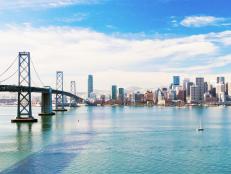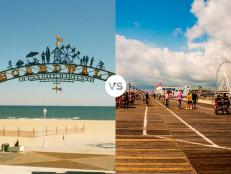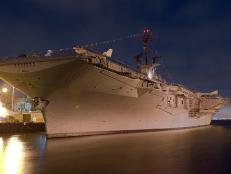Seven Wonders of the United States

Take an inside look at 7 man-made wonders of the US. From a sculpture carved out of a mountain to bridges of magnificent beauty, these wonders are marvels of engineering and design and works of pure genius.
Brooklyn Bridge
Where: East River, Park Row, Manhattan to Adams Street, Brooklyn, NY
In the early 1800s, the residents of Brooklyn and Lower Manhattan discussed the idea of a bridge to link the 2 cities together -- allowing people and goods to easily cross the East River. After multiple attempts to get something underway, John Roebling, a bridge designer, proposed a suspension bridge in 1855. Believe it or not, he actually designed the bridge hoping that it would be perceived as a great work of art one day. The proposal was approved 2 years later and work began on Jan. 3, 1870. Roebling had since passed away, so his son, Washington, took over as chief engineer of the project with help from his wife, Emily. Even before it opened in 1883, the bridge was seen as a symbol of greatness in New York, but folks across America were also mesmerized by the size and ingenuity of the project. Today, the bridge is a National Historic Landmark and still has the 44th longest main span among the world's suspension bridges.
Empire State Building
Where: 350 5th Avenue, New York, NY
Built during the Depression, the Empire State Building is a work of determination and pride both in New York and U.S. history. It all started when the Chrysler Corporation and General Motors were in competition to build the tallest building. Architect William Lamb was chosen to design the building and construction began in March 1930. By October that same year, 88 floors were finished with just 14 left to go. Workers were able to maintain this speedy construction pace since the posts, beams and windows were made in factories and then brought in by train to be put up on site. During the time the building was built, there was much talk among New Yorkers and Americans across the country about the incredible speed at which the building was being constructed, as well as weekly updates and stories about the men who built it. The Empire State Building is also a National Historic Landmark.
Golden Gate Bridge
Where: Located on US Highway 101 in San Francisco, CA
Millions of visitors each year flock to San Francisco for warmer weather, unique attractions and to see the Golden Gate Bridge. It was Joseph Strauss who submitted final plans for the bridge in 1930. The 6 counties involved with the bridge approved the $35 million project, and on Jan. 5, 1933, construction began. Just a few short years later, in 1937, the Golden Gate Bridge welcomed its first visitor. To everyone's surprise, it opened ahead of schedule and under budget. Since then, the bridge has been the recipient of numerous awards and accolades, such as the first non-building structure to receive the "Distinguished Building Award" from the Society of American Registered Architects. The bridge can also be found on a commemorative stamp unveiled in 1998 by the United States Postal Service.
Hoover Dam
Where: The dam is located 30 miles southeast of Las Vegas on US Highway 93 at the Nevada-Arizona border.
It took over 60 years from the time Maj. John Wesley Powell began to conduct geological studies of the Colorado River in 1869, to the concrete being poured in 1933, for Hoover Dam to be materialized. During this time the 7 basin states had to go through lengthy negotiations on how the water would be distributed, and of course, there were bidding wars on what construction company would get the job. In the end, a group called Six Companies was awarded the contract -- the winning bid was over $48 million. Despite the long years of bids, planning, site inspections and more, it took just five years to complete the mammoth structure. Today, the dam is a testament to the dedication of the country's ability to construct such a structure, especially during the years of the Depression. Hoover Dam is also a National Historic Landmark.
Mount Rushmore
Where: The Black Hills of South Dakota, along Highway 244
The location of Mount Rushmore was once property of the Sioux, including an area called the Black Hills. But once gold was discovered there, prospectors soon displaced the Sioux and began building mining camps. In 1885, an American businessman named Charles Rushmore paid a visit to the Black Hills to check on some titles to properties for a mining company. It was a few years later, after winning over the hearts of the miners and prospectors, that the mountain was named in his honor. So how did those faces end up on the rock? Historian Doane Robinson, in 1923, started the process that later turned into the Mount Harney Bill, allowing a monument to be carved. Sculptor Gutzon Borglum arrived two years later to begin the carving. The monument was officially completed on Oct. 31, 1941. Today, Mount Rushmore sees over 2.6 million visitors per year.
Seattle Space Needle
Where: 219 4th Avenue N, Seattle, WA
Designed for the 1962 World's Fair by Edward E. Carlson, this 605-foot-tall structure was to represent the future but quickly became a symbol for the city of Seattle. The structure is designed to withstand winds of 200 miles per hour, but earth tremors and storms have caused the structure to sway occasionally and close for a day or two. Today, the Space Needle is getting a face-lift as the city of Seattle begins to revitalize the entire centerpiece, including the observation deck, restaurant and surrounding grounds.
Washington Monument
Where: 15th Street, SW, Washington, DC
It doesn't matter what part of the world people come from, one sight of this obelisk design and they know they're in America. Similar to other memorials such as the Taj Mahal or the Great Pyramids, the Washington Monument is a celebration of 1 person's life or legacy -- in this case, the life of America's first president, George Washington. Architect Robert Mills won a contest to design the sculpture. It was intended to be the centerpiece of the capital city, symbolizing each state of the Union. Work on the monument began in 1843, and was completed in 1884. It is 555 feet tall and contains over 36,000 blocks.







































